Astronomy fanatica
-
Astronomy Picture of the Day
2005 July 2
Three Planets by the Sea
Explanation: On Tuesday, June 28th, the setting Sun flooded the horizon with a beautiful warm light in this view from the beach beside the pier at Brighton in Adelaide, South Australia. The Sun also illuminated three planets gathered in the western sky, Mercury, Venus, and Saturn. From this perspective Mercury is at the highest point in the celestial triangle, brilliant Venus is just below, and Saturn stands farther to the left and below the close pair. Of course, the planets only appear close together on the sky but are actually quite far apart in space. The orbits of Mercury and Venus are both interior to Earth's orbit, while gas giant Saturn lies in the outer solar system, over nine astronomical units from the Sun. Late next week, Venus and Mercury will share western skies with the young crescent Moon.
Credit & Copyright: Damian Sparkes -
Stjerneborg
Stjerneborg was Tycho Brahe's underground observatory next to his palace-observatory Uraniborg.
Tycho Brahe's Stjerneborg observatory on the island on Hven, Sweden
Tycho Brahe built it circa 1581 when he found Uraniborg neither stable nor large enough for his precision instruments. He named it Stellaburgi in Latin, meaning castle of the stars.
This image is a drawing by Willem Blaeu of the Stjerneborg observatory circa 1595, it is taken from an Atlas by his son, Johan Blaeu, published in 1662 in Amsterdam. The lettered annotations are explained in this plan-view schematic below.
The underground portions of the observatory have survived and are today fitted with a roof approximating the original one and the chambers are open to the public.
A schematic of Tycho Brahe's subterranean astronomical observatory Stjerneborg (Stelleburgi).
This plan-view schematic shows the observatory bounded by a square wall with semi-circular extensions on each side, the entrance on the left lies in the direction of the nearby palace Uraniborg. Annotations are:
- A = Entrance with steps leading down into the main workroom (B) and (D) and (E), above are three lion sculptures and Latin inscriptions
- B = The main Workroom containing (P) and (V) and passages to (C), (F), (G), and (Q)
- C = chamber with large equatorial instrument
- D = chamber with elevation and azimuth quadrant
- E = chamber with armillary sphere
- F = chamber with elevation and azimuth quadrant encompassed by a steel square
- G = chamber with sextant for measuring distances
- H = stone pillars one with a ball on top, the other angled, situated at the near side
- I = stone pillars one with a ball on top, the other angled, situated at the far side
- K, L, N and T = large balls, with conical covers, used for mounting instruments
- M = Stone table, shown with sundial in Willem Blaeu's drawing
- O = bed of Tycho Brahe
- P = fireplace
- Q = Tycho's assistant's bedroom
- S = beginning of an underground passage to Uraniborg
- V = worktable
Issue #131 -
Astronomy Picture of the Day
2005 July 3
A Swift Look at Tempel 1
Explanation: Comet Tempel 1 is targeted for a collision with the impactor probe from NASA's Deep Impact Spacecraft at about 1:52am EDT on July 4th (other time zones). Cameras on the impactor probe and the flyby spacecraft will capture close-up images of the event - expected to produce a crater on the surface of the comet's nucleus. Of course, Earth-orbiting and ground-based telescopes will be watching too, including instruments on the Swift satellite normally used to spot gamma-ray bursts in the distant universe. Swift's ultraviolet telescope recorded this picture of Tempel 1 on June 29th. Because the image is registered on the comet, the background stars appear as short trails. Want to follow the encounter? Media coverage chronicling the event, and the possibilities for viewing the comet with small telescopes can be found through the Deep Impact website.
Credit: UVOT Team, Swift, NASA -
Sudbury Neutrino Observatory
The Sudbury Neutrino Observatory (SNO) is located 6,800 feet underground in an active nickel mine (INCO's Creighton Mine) in Greater Sudbury, Ontario, Canada.
Artist's concept of the Sudbury Neutrino Observatory detector
The detector is designed to detect solar neutrinos through their interactions with deuterium nuclei. The detector target is 1,000 tonnes of heavy water contained in a 6 meter radius acrylic vessel, and the detector cavity is filled with light water to provide buoyancy for the vessel and radioactive shielding. The heavy water is viewed by 9,600 single photon detectors known as Photomultiplier Tubes (PMTs) mounted on a geodesic sphere at a radius of about 850 cm.
The experiment does not directly detect neutrinos, but rather observes the light produced by relativistic electrons in the water. As relativistic electrons lose energy they produce a cone of blue light through the Cerenkov effect, and it is this light that is directly detected.
The detector was designed to solve the solar neutrino problem, as well as to search for evidence of neutrino flavour change (neutrino oscillation). SNO is capable of detecting all three neutrino flavours unlike other detectors such as Super-Kamiokande that can only detect the electron and tau types.
The first measurements of the number of solar neutrinos reaching the earth were taken in the 1960s, and all experiments prior to SNO observed a third to a half fewer neutrinos than were predicted by the Standard Solar Model. One of the possible explanations for the reduced flux was the theory of neutrino flavor oscillation: the neutrinos emitted by the sun would undergo fundamental changes into other types of neutrinos as they travel through the sun. On June 18th, 2001, the first scientific results of the Observatory were published, bringing the first clear evidence that this theory was correct. The actual flux of neutrinos measured by SNO coincides with the theoretical output. Further measurements carried out by the Observatory have since confirmed this result.
SNO in action
SNO is also capable of detecting a supernova within our galaxy. As neutrinos emitted by a supernova are released earlier than the photons, it would be possible to alert the astronomical community before the supernova was visible. SNO is a founding member of SNEWS with Super-Kamiokande and LVD.
Asteroid (14724) SNO is named in honour of the Observatory.
The Sudbury Neutrino Observatory is a major setting in the Neanderthal Parallax trilogy by Canadian science fiction author Robert J. Sawyer.
Issue #132 -
Astronomy Picture of the Day
2005 July 4
A Panorama from Mauna Kea
Explanation: Typically, views from Mauna Kea are up and dark. That's because the famous dormant volcano in Hawaii is arguably Earth's premier observing platform of the complex and ever changing night sky. However, this daytime view is across and bright. White snow and white clouds seem to blend together to make an alien landscape. Cinder cones from extinct volcanic outbursts dominate the foreground. Scrolling right will reveal structures visually incongruous even here: an armada of the largest optical telescopes on Earth. The observatories seen include Subaru and Keck. In the distance on the far left is Mauna Loa, Earth's largest volcano.
Credit & Copyright: Jean-Charles Cuillandre (CFHT), Hawaiian Starlight, CFHT -
Uppsala Astronomical Observatory
The Uppsala Astronomical Obervatory is an astronomical observatory in Sweden. It was founded in 1730, though there was a professorial chair of astronomy at the University of Uppsala from 1593 and the university archives include lecture notes in astronomy from the 1480s.
In the 18th century, Anders Celsius performed his research there and built the first observatory proper in 1741. Celsius managed to get the university consistory to buy a large stone house (of probably medieval origin) in central Uppsala, where he had an observatory constructed on the rooftop. Celsius both worked and had his personal living quarters in the house. This observatory remained in use until the observatory now known as the "old observatory" was built in 1853. The Celsius house itself still remains as one of few older buildings on a modern shopping street, but the observatory on the roof was demolished in 1857.
The house of Anders Celsius with his observatory on the roof, from a contemporary engraving.
In the 19th century Anders Jonas Ångström was keeper of the observatory and conducted his experiments in astronomy, physics and optics there. His son, Knut Ångström, also conducted research on solar radiation at the observatory.
The observatory recently merged with the Institute of Space Physics to form a Department of Astronomy and Space Physics and moved to the Ångström Laboratory. In addition to facilities in Uppsala, the observatory maintains the Kvistaberg Observatory in Sweden and the Uppsala Southern Station at Mount Stromlo and Siding Spring Observatory in Australia.
Research at the observatory over the years includes stellar parallaxes, stellar statistics, galactic structure, external galaxies, stellar atmospheres and solar system research.
Issue #133 -
Astronomy Picture of the Day
2005 July 5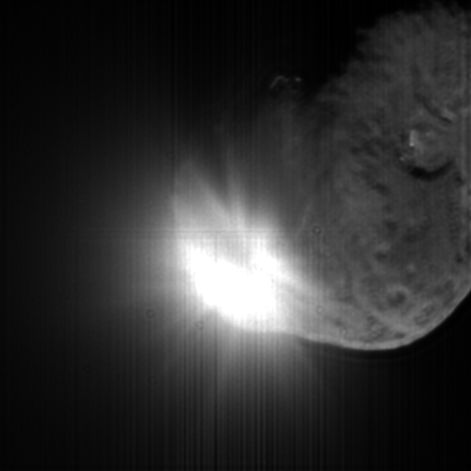
Thirteen Seconds After Impact
Explanation: Fireworks came early on July 4th when, at 1:52am EDT, the Deep Impact spacecraft's probe smashed into the surface of Comet Tempel 1's nucleus at ten kilometers per second. The well-targeted impactor probe was vaporized as it blasted out an expanding cloud of material, seen here 13 seconds after the collision. The image is part of a stunning series of frames documenting the event from the high resolution camera onboard the flyby spacecraft. Tempel 1's potato-shaped nucleus is approximately 5 kilometers across as seen from this perspective. Camera's onboard the impactor probe were also able to image the nucleus and impact site up-close ... until about 3 seconds before the impact. Of course, telescopes nearer to planet Earth followed the event, detecting a significant brightening of comet Tempel 1.
Credit: Univ. Maryland, JPL-Caltech, NASA -
Uraniborg
Uraniborg was the astronomical/astrological observatory of Tycho Brahe; built circa 1576-1580 on Hven (also known as Ven or Hveen), an island in the Öresund; between Zealand and Scania.
A painting of Tycho Brahe's Uraniborg palace-observatory from his 1598 book.
Tycho wrote that on August 8, 1576, they laid the cornerstone. The building was dedicated to Urania, the Muse of Astronomy and named Uraniborg, "The Castle of Urania."
Uraniborg became a kind of early "research institute", which attracted students from many regions. The palace also held equipment for alchemical research, and the gardens held herbs and flowers in geometrically laid out patterns. Nearby was Tycho's subterranean Stjerneborg observatory which he built when he found Uraniborg not stable enough for his precision instruments. On losing support from the king Christian IV of Denmark Tycho abandoned Ven in 1597 and both Uraniborg and Stjerneborg were destroyed shortly after Tycho's death, although some parts of the Stjerneborg is restored, and open to the public.
Tycho Brahe's Uraniborg main building from the 1663 Blaeu's Atlas Major.
The gardens of Uraniborg are currently slowly being restored as part of a historical research project to use the species and varieties then extant.
Issue #134 -
Astronomy Picture of the Day
2005 July 6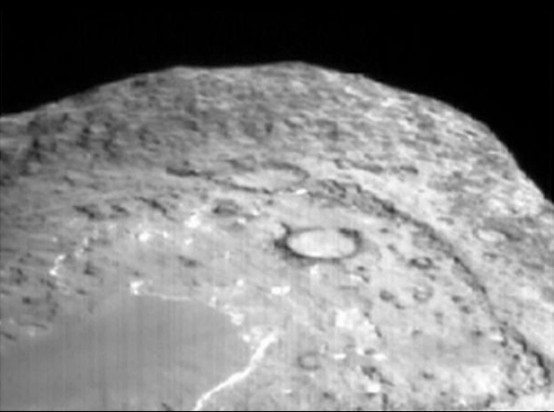
The Landscape on Comet Tempel 1
Explanation: This diverse landscape is the surface of comet Temple 1's nucleus as seen by the Deep Impact probe's Impactor Targeting Sensor. Within minutes of recording the rugged view, the landscape had changed dramatically though, as the impactor smashed into the surface near the two large, half kilometer-sized craters at picture center. Indications are that the probe penetrated well below the surface before vaporizing, sending a relatively narrow plume of debris blasting back into space. Researchers are still speculating on the final size of the crater produced by the July 4th comet crash, but material continues to spew from the impact site and has caused the faint comet to brighten significantly. Determining the crater dimensions and analyzing the debris ejected from the comet's interior will provide premier insights into the formation of comet Tempel 1, a primordial chunk of our own solar system.
Credit: Univ. Maryland, JPL-Caltech, NASA -
United States Naval Observatory
The United States Naval Observatory (USNO) is one of the oldest scientific agencies in the United States. It is located in Northwest Washington, D.C.. It is one of the very few observatories located in an urban area (when it was initially constructed, it was far from the light pollution generated by the then-smaller city center).
Aerial view of the United States Naval Observatory
Established in 1830 as the Depot of Charts and Instruments, the observatory's primary mission was to care for the U.S. Navy's chronometers, charts and other navigational equipment. It calibrated ships' chronometers by timing the transit of stars across the meridian. Initially located downtown in Foggy Bottom (near the Lincoln Memorial and the Kennedy Center), the observatory moved to its present location in 1893, atop Observatory Hill overlooking Massachusetts Avenue, amidst perfectly circular grounds.
Today, the U.S. Naval Observatory is the preeminent authority in the areas of time-keeping and celestial observation. It determines and distributes the timing and astronomical data required for accurate navigation and fundamental astronomy, but perhaps it is best known to the general public for its highly accurate ensemble of atomic clocks.
Since 1974 Number One Observatory Circle, a house situated in the grounds of the observatory (formerly the residence of its superintendent), has been the official residence of the Vice President of the United States.
Issue #135 -
Astronomy Picture of the Day
2005 July 7
Fire Glow and Star Trails at Sunset Crater
Explanation: Stars gracefully arc over the glow from a not too distant forest fire in this dramatic time exposure. A recent camping trip with family and friends to Sunset Crater Volcano National Monument, near Flagstaff, Arizona, USA produced the opportunity to record the subtle lighting from Earth and sky. Pointed south with the shutter held open for five minutes, camera and tripod were fixed to planet Earth, producing the gently curving, concentric star trails - a reflection of the planet's daily rotation about its axis. Rising beyond the forest fire's glow is the slope of Sunset Crater, a cinder cone produced by volcanic eruptions some 900 years ago.
Credit & Copyright: Rick Scott -
WIYN Observatory
The WIYN Observatory is owned and operated by the WIYN Consortium. The WIYN Consortium consists of the University of Wisconsin (W), Indiana University (I), Yale University (Y), and the National Optical Astronomy Observatories (N).
Its telescope, a 3.5-meter instrument, is the newest and second largest telescope at the Kitt Peak National Observatory. Most of the capital costs of the observatory were provided by the University of Wisconsin, Indiana University, and Yale University, while the National Optical Astronomy Observatory provides most of the operating services.
The telescope at the WIYN Observatory.
Issue #136 -
Astronomy Picture of the Day
2005 July 8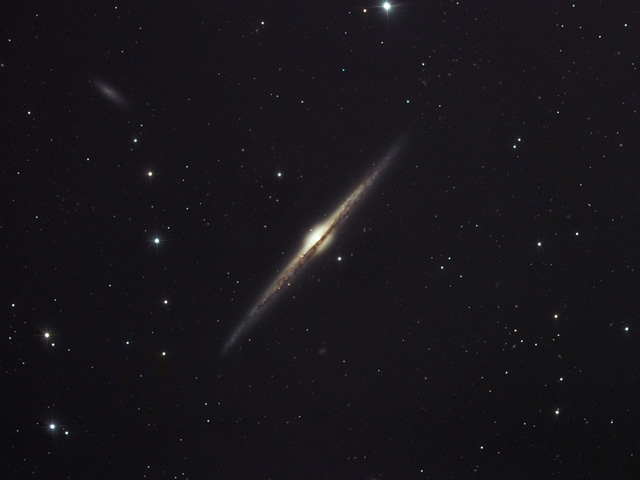
NGC 4565: Galaxy on the Edge
Explanation: Magnificent spiral galaxy NGC 4565 is viewed edge-on from planet Earth. Also known as the Needle Galaxy for its narrow profile, bright NGC 4565 is a stop on many telescopic tours of the northern sky as it lies in the faint but well-groomed constellation Coma Berenices. This sharp color image reveals the galaxy's bulging central core dominated by light from a population of older, yellowish stars. The core is dramatically cut by obscuring dust lanes which lace NGC 4565's thin galactic plane. A large island universe similar to our own Milky Way Galaxy, NGC 4565 is only about 30 million light-years distant, but over 100,000 light-years in diameter. In fact, some consider NGC 4565 to be a prominent celestial masterpiece Messier missed.
Credit & Copyright: Robert Gendler -
Astronomy Picture of the Day
2005 July 9
The Colorful Clouds of Rho Ophiuchi
Explanation: The many spectacular colors of the Rho Ophiuchi (oh'-fee-yu-kee) clouds highlight the many processes that occur there. The blue regions shine primarily by reflected light. Blue light from the star Rho Ophiuchi and nearby stars reflects more efficiently off this portion of the nebula than red light. The Earth's daytime sky appears blue for the same reason. The red and yellow regions shine primarily because of emission from the nebula's atomic and molecular gas. Light from nearby blue stars - more energetic than the bright star Antares - knocks electrons away from the gas, which then shines when the electrons recombine with the gas. The dark regions are caused by dust grains - born in young stellar atmospheres - which effectively block light emitted behind them. The Rho Ophiuchi star clouds, well in front of the globular cluster M4 visible above on far lower left, are even more colorful than humans can see - the clouds emits light in every wavelength band from the radio to the gamma-ray.
Credit: Adam Block (KPNO Visitor Program), NOAO, AURA, NSF -
Yerkes Observatory
The Yerkes Observatory is an astronomy observatory of the University of Chicago, in Williams Bay, Wisconsin. It was created in 1897 by George Ellery Hale and financed by Charles T. Yerkes. The observatory represented a shift in the thinking of observatories, from mere housing for a telescope and observer, to the modern concept of observation equipment integrated with laboratory space for physics and chemistry. A 102 cm (40 inch) refracting telescope is located inside; it was the largest telescope until the construction of Mount Wilson's reflector. It remains the largest refracting telescope ever used.
The 102 cm (40 inch) refractor at the Yerkes Observatory.
In addition to the Yerkes refractor, the observatory also has a 102 cm (40 inch) and a 61 cm (24 inch) reflecting telescope. Several smaller telescopes are used for educational outreach purposes.
Current research includes the interstellar medium, globular cluster formation, infrared astronomy, and near-Earth objects. Additionally, the University of Chicago maintains a sizable engineering center in the observatory, dedicated to making and maintaining scientific instruments.
The current director is Dr. Kyle M. Cudworth. In March, 2005, the University of Chicago announced plans to sell the observatory and its land. Initial reports had two purchasers interested, an east coast developer who wants to build luxury homes and Aurora University, which has a campus straddling the Williams Bay property. The Geneva Lake Conservancy, a regional conservation and land trust organization, has taken the position that it is critical to save, in place, the historic Yerkes Observatory structures and telescopes for education and research, as well as to conserve the rare undeveloped, wooded lakefront and deep forest sections of the 77 acre (312,000 m²) site.
Issue #137 -
Astronomy Picture of the Day
2005 July 10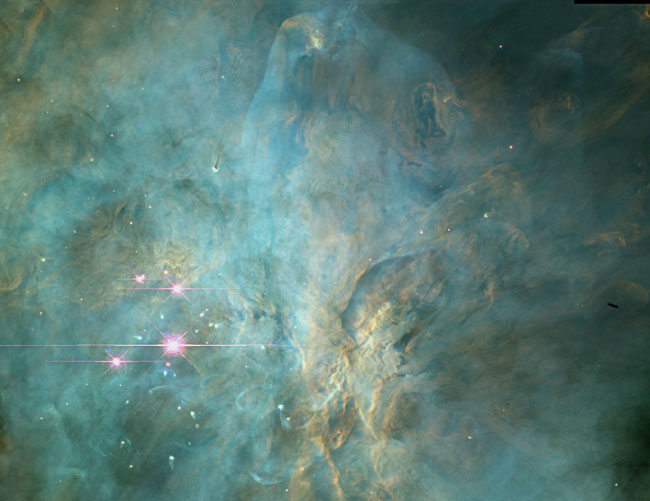
In the Center of the Trapezium
Explanation: Start with the constellation of Orion. Near Orion's belt is a fuzzy area known as the Great Nebula of Orion or M42. In this nebula is a bright star cluster known as the Trapezium, shown above. New stellar systems are forming there in gigantic globs of gas and dust known as Proplyds. Looking closely at the above picture also reveals that gas and dust surrounding some of the dimmer stars appears to form structures that point away from the brighter stars. The above false color image was made by combining several exposures from the orbiting Hubble Space Telescope.
Credit: J. Bally, D. Devine, & R. Sutherland, D. Johnson (CITA), HST, NASA -
Gran Telescopio Canarias
The Gran Telescopio Canarias (GTC) ("Great Telescope Canary Islands"), sometimes called Grantecan, is a 10.4 m reflecting telescope being built at the Observatory of Roque de los Muchachos on the island of La Palma.
The Gran Telescopio Canarias under construction in 2002.
GTC will start observing in late 2005. Its primary mirror is formed by 36 hexagonal segments fully controlled by an active optics control system. The GTC Project is a partnership formed by several institutions from Spain, Mexico and the University of Florida (USA) and an initiative from the Instituto de AstrofÃsica de Canarias (IAC).
Its Day One instruments are OSIRIS and CanariCam.
Issue #138 -
Astronomy Picture of the Day
2005 July 11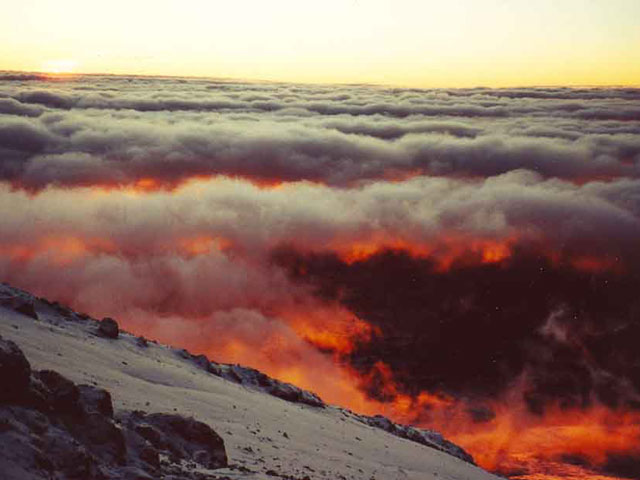
Sunrise Over Kilimanjaro
Explanation: Is the Roof of Africa on fire? A group hiking at 6 am near the top of Mt. Kilimanjaro watched the rising sun peak above the clouds and the horizon light up red. Don't worry -- in this case the highest volcano in Africa is not even erupting. The spectacular sunrise colors are caused by light scattering off the atmosphere and small cloud particles. If all of the scattered light that makes the sky blue were added back into the scene, the sunrise would appear Sun-colored and not so red. A similar light scattering effect involving small airborne dust particles causes sunsets on Mars to be red and has been used to determine the sizes of particles in the rings of Saturn. During this trek in 2000 November, a group of about 30 reached the Kilomanjaro summit after a six-day climb.
Credit & Copyright: Clayton Hogen-Chin (U. Minnesota) -
Hey Mr Poon. .. i am doing a project on brown dwarves.. you know anything about them??
-
u'll find it on page 4 of this threadOriginally posted by DriftingGuy:Hey Mr Poon. .. i am doing a project on brown dwarves.. you know anything about them??

-
Hey.. was kinda surprised that it was actually very helpful! Thanks Mr PoonOriginally posted by poon cho tang:u'll find it on page 4 of this thread

-
no probOriginally posted by DriftingGuy:Hey.. was kinda surprised that it was actually very helpful! Thanks Mr Poon

-
Astronomy Picture of the Day
2005 July 12
Launch of the Red Bird
Explanation: Glare and exhaust from the three stage, solid fuel M-V-6 rocket punctuates a perfect launch of the Astro-E2 observatory. The dramatic picture was taken at the Uchinoura Space Center on July 10 at 12:30 JST. For dedicated astronomers, a celebration is definitely in order as this launch is a reflight of the Astro-E payload, originally destroyed in a launch failure in February 2000. Now being checked out in Earth orbit, the innovative instrumentation on board the satellite will explore the Universe in energetic x-rays. Following a tradition of renaming satellites after their successful launch, Astro-E2 has been newly dubbed Suzaku. Suzaku, a phoenix-like deity in mythology associated with the southern part of the sky, is a 'Red Bird'.
Image Credit: Dr. F. Scott Porter, Exploration of the Universe Division, GSFC -
Astronomy Picture of the Day
2005 July 13
Analemma of the Moon
Explanation: An analemma is that figure-8 curve you get when you mark the position of the Sun at the same time each day for one year. But the trick to imaging an analemma of the Moon is to understand that on average the Moon returns to the same position in the sky about 51 minutes later each day. So, if you photograph the Moon 51 minutes later on successive days, over one lunation or lunar month it will trace out an analemma-like curve as the actual position of the Moon wanders compared to the average -- due to the Moon's tilted and elliptical orbit. For this excellent demonstration of the lunar analemma, astronomer Rich Richins chose the lunar month containing this year's northern hemisphere summer solstice. The southernmost Full Moon rises at the lower right above the Organ Mountains in southern New Mexico, USA, with the New Moon phase at the upper left. The multiple exposure image required some digital manipulation, particularly to include thin crescent phases in daytime skies.
Credit & Copyright: Rich Richins -
Keck telescopes
The W.M. Keck telescopes are the two largest optical/near-infrared telescopes of the Mauna Kea Observatory on Mauna Kea in Hawai'i. These are reflecting telescopes located at an altitude of 4,145 m (13,600 ft). Keck I started observing in 1993 and Keck II started in 1996. This is a Ritchey-Chrétien type of telescope on an altazimuth mount, assisted by active optics. The Keck telescopes have, essentially, 10 m mirrors; however, rather than having one mirror each telescope has 36 smaller hexagonal mirrors working together. In addition, Keck I and II can work together, via interferometry; this gives them the effective power of an 85 m mirror.
The Mauna Kea Observatory, an institute of the University of Hawai'i, is considered one of the most important land-based observatories in the world for its isolated, unobstructed views of space without interference from man-made light sources. The twin Keck telescopes are the largest of its optical/near-infrared instruments.
The telescopes are administered by the University of California, California Institute of Technology and the National Aeronautics and Space Administration. They sit on land leased from the University of Hawai'i System based in Honolulu, Hawai'i.
Issue #139